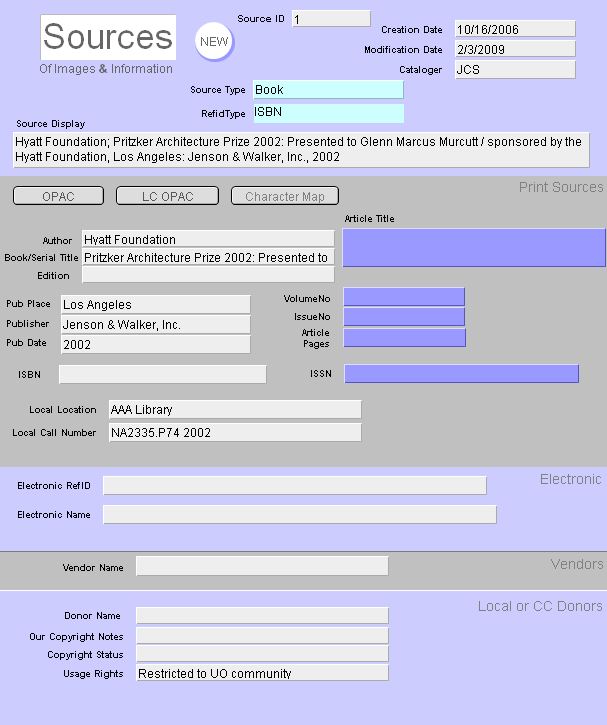Vcat Best Practices:
Source
Source and Order
are used for Pre-cataloging (see Order Tracking Sheet). The Staff
usually handle Pre-Cataloging, though a Cataloger may be asked to fill out
Source and Order records for special projects. Source records record
information about where cataloging information was gathered, or from where
images were found for digitization. Sources can include, books, articles,
vendors or patrons who donate images. Please fill out the Source record as
completely as possible.

|
Field
Name |
Local
Usage |
Notes |
|
Source ID |
Auto-generated |
Primary key for the Source
facet |
|
Creation Date |
Auto-generated |
|
|
Modification Date |
Auto-generated |
|
|
Cataloger |
Pull-down menu |
Entries from the Cataloger
Table |
|
Source Display |
Auto-fills from fielded
information below |
The Display is formatted
to produce MLS bibliographic entries for books and other materials |
|
Source Type |
Pull-down menu |
Always fill in this field,
as it effects the Source Display |
|
Author |
Use Last, First format; or Last,
First and First Last; or Last, First, First
Last and First Last; for more than 3 authors, use Last, First, et al. |
You may use the UO
catalog, Summit or WorldCat as authorities |
|
Book or Serial Title |
Use Title Case; drop initial articles; use colons between title: subtitle; |
You may use the UO
catalog, Summit or WorldCat as authorities |
|
Edition |
Include Edition as in source; write out numbers |
You may use the UO
catalog, Summit or WorldCat as authorities |
|
Publisher Place |
As source |
Although there may be
multiple places listed on the title page, the materials can only have been
published in one place. To determine the place you may need to look carefully
at the information on the verso of the title page or colophon, or use the UO
catalog, Summit or WorldCat as authorities. |
|
Publisher Name |
As source |
There may be multiple
publishers listed on the title page, particularly if the original text was
produced outside the US and an American distributor was used. You may need to
look carefully at the information on the verso of the title page or colophon,
or use the UO catalog, Summit or WorldCat as authorities to determine the
publisher and/or the distributor. |
|
Published Date |
As source |
This is often but not
always the copyright date. You may need to look carefully at the information
on the verso of the title page or colophon, or use the UO catalog, Summit or
WorldCat as authorities. |
|
ISBN |
Do not use dashes or
spaces |
ISBNs were not implemented
until 1970 and were not widely used until the mid 70s. Small press books and
some foreign books may not have ISBNs. |
|
Local Location |
Pull-down menu |
|
|
Local Call Number |
Use
library prefix in all caps except for oversize xs;
do NOT use spaces except between the last cutter number and the year |
Example: xNB550.H43C9
1988 |
|
Article Title |
Do not use quotation marks |
Punctuation is added in
the Source Display automatically. |
|
Volume No |
Do not use vol. |
Punctuation is added in
the Source Display automatically. |
|
Issue No |
Do not use no. |
Punctuation is added in
the Source Display automatically. |
|
Article Pages |
Do not use pg., pp,
pps. |
Punctuation is added in
the Source Display automatically. |
|
ISSN |
Do not use dashes or
spaces |
See ISBN |
|
Electronic RefID |
Use
sources format |
Use URIs or URLs for
electronic resources with persistent locations. |
|
Electronic Name |
As source |
Name of the corporate entity
or individual responsible for providing the materials. If unknown, use site
name. |
|
Vendor Name |
As source |
Used for purchased images |
|
Donor Name |
Use
natural order name, First Last of donor |
Used for gift materials or
originals. See Staff/Gift Collections database for established collection
titles. |
|
Our Copyright Notes |
Free text, as needed |
If the general copyright
rules do not apply, as in the case of some gift materials, record that
information here. |
|
Copyright Status |
Free text, as needed |
|
|
Usage Rights |
Auto-generated, but
editable as needed |
|
Continue to Order